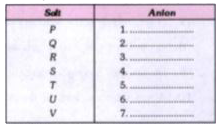State the clour of -
Copper [II] hydroxide solution after addition of ammonium hydroxide in excess to it .
To determine the color of the Copper (II) hydroxide solution after the addition of ammonium hydroxide in excess, we can follow these steps:
1. Identify the Initial Solution:
- Start with a clear light blue aqueous solution of Copper (II) hydroxide, which has the formula Cu(OH)₂.
2. Add Ammonium Hydroxide:
- When ammonium hydroxide (NH₄OH) is added to the Copper (II) hydroxide solution, a reaction occurs.
3. Write the Reaction:
- The reaction can be represented as:
Cu(OH)2+4NH4OH→(Cu(NH3)4)2++2H2O
- Here, Copper (II) hydroxide reacts with ammonium hydroxide to form a complex ion known as tetraamminecopper(II) hydroxide.
4. Determine the Color of the Product:
- The resulting complex, tetraamminecopper(II), is known to have a deep blue color.
5. Conclusion:
- Therefore, after the addition of excess ammonium hydroxide to the Copper (II) hydroxide solution, the color of the solution changes to deep blue.
Final Answer:
The color of the Copper (II) hydroxide solution after the addition of ammonium hydroxide in excess is deep blue.
- Start with a clear light blue aqueous solution of Copper (II) hydroxide, which has the formula Cu(OH)₂.
- When ammonium hydroxide (NH₄OH) is added to the Copper (II) hydroxide solution, a reaction occurs.
- The reaction can be represented as:
Cu(OH)2+4NH4OH→(Cu(NH3)4)2++2H2O
- Here, Copper (II) hydroxide reacts with ammonium hydroxide to form a complex ion known as tetraamminecopper(II) hydroxide.
- The resulting complex, tetraamminecopper(II), is known to have a deep blue color.
- Therefore, after the addition of excess ammonium hydroxide to the Copper (II) hydroxide solution, the color of the solution changes to deep blue.
The color of the Copper (II) hydroxide solution after the addition of ammonium hydroxide in excess is deep blue.
Topper's Solved these Questions
- STUDY OF COMPOUNDS - AMMONIA BOOK - ICSECHAPTER - STUDY OF COMPOUNDS - AMMONIA EXERCISE - ADDITIONAL QUESTIONS
30 Videos
- STUDY OF ACIDS, BASES AND SALTSBOOK - ICSECHAPTER - STUDY OF ACIDS, BASES AND SALTSEXERCISE - ASSERTION AND REASON BASED QUESTIONS
5 Videos
- STUDY OF COMPOUNDS - HYDROGEN CHLORIDEBOOK - ICSECHAPTER - STUDY OF COMPOUNDS - HYDROGEN CHLORIDEEXERCISE - UNIT TEST PAPER 7A - HYDROGEN CHLORIDE
28 Videos
Similar Questions
State the clour of -
The solution obtained on addition of excess ammonium hydroxide to zinc sulphate solution.
View SolutionName a hydroxide which is soluble in excess of ammonium hydroxide.
View SolutionName :
a hydroxide which is soluble in excess of ammonium hydroxide.
View SolutionSalts P, Q,R,S,T,U and V undergo reactions (i) to (vii) respectively. Identify the cation present in these salts on the basis of these reactions. Tabulate your answer in the formate given below.
(i) When the salt Pis heated with sodium hydroxide solution a vigorous reaction takes place and a colourless gas is evolved with a pungent and suffocating smell that brings tears in our eyes. The evolved gas gives dense white fumes with a moist glass rod depped with hydrochloric acid.
(ii) Addition of sodium hydroxide solution to a solution of salt Q gives a thick white precipitae which is soluble in excess of sodium hydroxide solution to form a clear solution.
(iii) Addition of ammonium hydroxide solution to a solution of salt R gives a dark blue precipitate which is soluble is excess of ammonium hydroxide solution to form an intense deep blue solution.
(iv) Addition of ammonium hydroxide solution to a solution of 5 gives a dirty green [bottle green] precipitate which is insoluble even in the excess of ammonium hydroxide solution.
(v) Addition of ammonium hydroxide solution to a solution of T gives a reddish brown (rust precipitate] precipitate which is insoluble even in the excess of ammonium hydroxide solution.
(vi) Addition of ammonium hydroxide solution to a solution of V gives a geletaneous white precipitate which is soluble in excess of ammonium hydroxide solution to form a clear solution.
(vii) Addition of ammonium hydroxide solution to a solution of V gives no precipitate but it gives a chalky white precipitate with sodium hydroxide solution which is insoluble even in the excess of sodium hydroxide solution.

View SolutionWhen to a copper sulphate solution , excess of ammonium hydroxide added then
View SolutionThe number of moles of Ammonium Hydroxide in 420 g is
View SolutionExplain the following:
(i). Copper hydroxide is soluble in ammonium hydroxide but not in sodium hydroxide.
(ii). A dark blue precipitate is formed when sodium hydroxide solution is added to copper sulphate solution. The precipitate darkens on heating.
View SolutionExplain the following facts:
(a). Copper hydroxide is soluble in ammonium hydroxide but not in sodium hydeoxide.
(b). Addition of an alkali to cuprous chloride solution gives a yellow precipitate which gradually changes to a red colour.
View SolutionState one appropriate observation
A few drops of dilute hydrochloric acid are added to silver nitrate solution, followed by addition of ammonium hydroxide solution.
View SolutionState one appropriate observation for each of the following:
A few drops of dilute hydrochloric acid are added to silver nitrate solution, followed by addition of ammonium hydroxide solution.
View Solution
